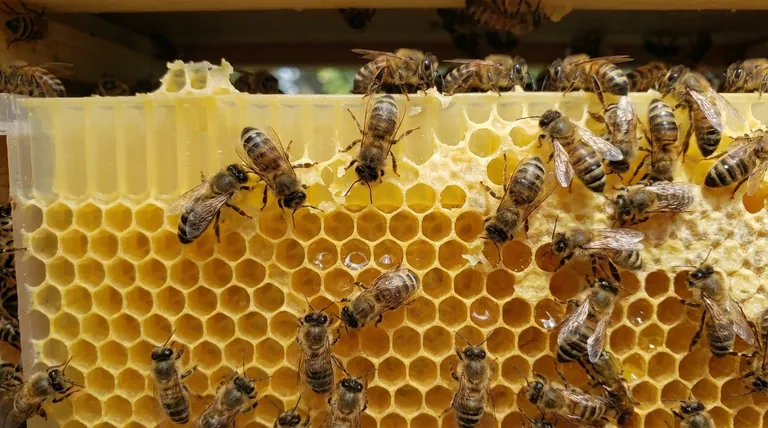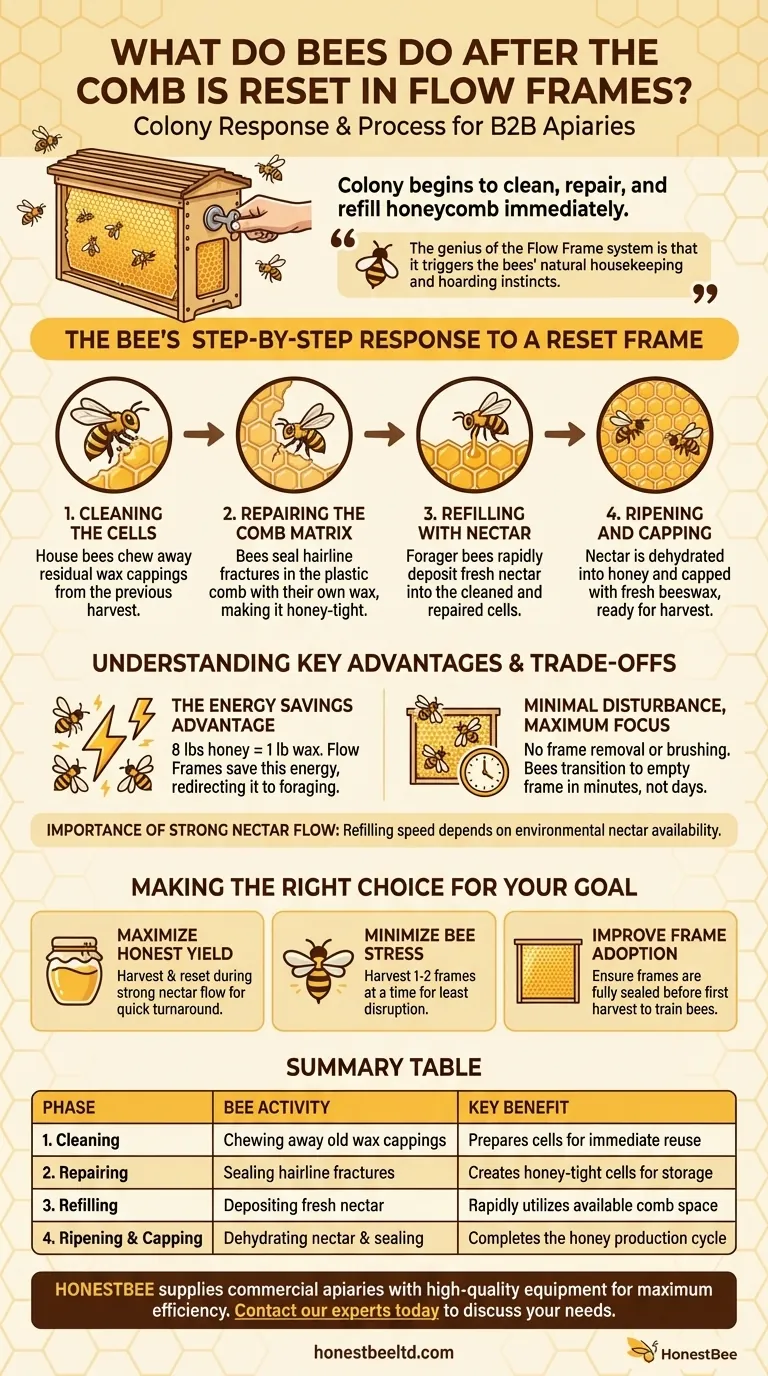After a Flow Frame is reset, the colony's worker bees immediately begin to clean, repair, and refill the honeycomb cells. They instinctively chew away the remnants of the previous wax cappings and treat the empty cells as new storage space, kickstarting the honey production process all over again.
The genius of the Flow Frame system is that it triggers the bees' natural housekeeping and hoarding instincts. By leaving the core comb structure intact, it allows the hive to bypass the energy-intensive step of building new wax and redirect that effort directly into making more honey.

The Bee's Step-by-Step Response to a Reset Frame
When you reset a Flow Frame, you are essentially creating a clean slate that the bees are biologically programmed to fill. Their response is methodical and efficient, following a clear, four-phase process.
Phase 1: Cleaning the Cells
The first thing the bees notice is that the cells are open and empty, with residual wax from the previous cappings left behind. House bees immediately get to work, chewing away and removing this leftover wax to prepare the cells for use.
Phase 2: Repairing the Comb Matrix
After harvesting, the plastic cells of the Flow Frame return to their original, intact honeycomb shape, but tiny gaps remain where the parts moved. The bees use their own wax to seal these hairline fractures, making the cells perfectly honey-tight once more. This act of "completing the comb" is a critical step before they begin refilling.
Phase 3: Refilling with Nectar
With the cells cleaned and repaired, forager bees begin depositing fresh nectar. The hive treats these empty, pre-built cells as valuable real estate and works quickly to fill them, especially during a strong nectar flow.
Phase 4: Ripening and Capping
Once the cells are full, house bees begin the process of turning nectar into honey by fanning their wings to reduce its moisture content. When the honey is "ripe" (below ~18% moisture), they cap the cells with a fresh layer of beeswax, and the frame is ready for a future harvest.
Understanding the Key Advantages and Trade-offs
While the Flow Frame system streamlines the harvesting process, it's important to understand the factors that influence its effectiveness. The primary advantage is a massive savings in colony resources.
The Energy Savings Advantage
Bees must consume roughly eight pounds of honey to produce just one pound of wax. By preserving the comb structure, the Flow Frame allows the colony to save this enormous energy expenditure and dedicate more resources to foraging and honey production.
Minimal Disturbance, Maximum Focus
In traditional harvesting, frames are removed, bees are brushed off, and the colony is significantly disturbed. With Flow Frames, the bees remain on the comb surface, often unaware that the harvest is even happening. They can transition from a full frame to an empty one in minutes, not days.
The Importance of a Strong Nectar Flow
The speed at which bees refill a frame is entirely dependent on the availability of nectar in the surrounding environment. Resetting a frame during a nectar dearth will not magically produce honey; the bees can only fill the comb if they have resources to do so.
Making the Right Choice for Your Goal
Understanding this natural cycle allows you to manage your hive more effectively. Your timing and approach can be tailored to match your primary beekeeping objective.
- If your primary focus is maximizing honey yield: Harvest and reset frames during a strong nectar flow to take full advantage of the colony's quick turnaround time.
- If your primary focus is minimizing bee stress: Harvest just one or two frames at a time, which allows the colony to concentrate its repair efforts on a smaller area and causes the least possible disruption.
- If your bees are slow to adopt the frames: Ensure the frames are fully sealed and capped before your first harvest, as this "trains" the bees to use the entire surface properly for future cycles.
By working with the bees' innate behaviors, you can make the honey harvest an efficient and low-impact event for the entire colony.
Summary Table:
| Phase | Bee Activity | Key Benefit |
|---|---|---|
| 1. Cleaning | Chewing away old wax cappings | Prepares cells for immediate reuse |
| 2. Repairing | Sealing hairline fractures in the comb | Creates honey-tight cells for storage |
| 3. Refilling | Depositing fresh nectar into empty cells | Rapidly utilizes available comb space |
| 4. Ripening & Capping | Dehydrating nectar and sealing with new wax | Completes the honey production cycle |
Ready to streamline your honey harvest and boost your apiary's productivity? The Flow Frame system works in harmony with your bees' natural instincts. HONESTBEE supplies commercial apiaries and beekeeping equipment distributors with the high-quality, wholesale-focused beekeeping supplies and equipment needed to succeed. Let us help you equip your operation for maximum efficiency. Contact our experts today to discuss your needs and discover the right solutions for your business.
Visual Guide

Related Products
- 7 x Auto Bee Flow Hive Frames Plastic Beekeeping Hive Box Supplies
- Professional 500g Sectional Comb Honey Frame System for Beekeeping
- Professional In-Hive Frame Bee Feeder by HONESTBEE
- HONESTBEE Bee Frame Grooving Machine | Precision Slotting for Bee Frame Making
- Long Langstroth Style Horizontal Top Bar Hive for Wholesale
People Also Ask
- How do you clean plastic frames? A Gentle Guide to Preserving Your Frames
- What are the advantages of using an Auto Flow Hive? Experience Gentle, On-Tap Honey Harvesting
- What is the role of oxalic acid in plants? A Key to Plant Defense and Internal Regulation
- How long does it take for bees to fill a Flow Hive? A Guide to Realistic Timelines
- How to extract honey in Flow Hives? Experience the Simplicity of Honey on Tap



















